Kettle’s Yard: A Tour Through Cambridge’s Modern Art Gallery
Kettle’s Yard, a somewhat modest home in the middle of Cambridge, UK, harbors an impressive art collection of predominantly modern and abstract...
Ruxi Rusu 24 June 2024
The Dia Art Fountain in Beacon, New York was permitted to welcome visitors back in August, several weeks ahead of museums in New York City. Timed ticketed entry to minimize the traffic inside the gallery spaces, the enforcement of face coverings, and the faint scent of hand sanitizer wafting through the open spaces surprisingly complimented my first time to this cathedral of late 20th century Minimalist and Conceptual Art.
Dia Beacon opened in 2003 in a former Nabisco box making factory along the Hudson River, about a ninety minute drive north from New York City. This museum was conceived as a space for permanent to long-term installations. The foundation’s primary focus is on works from the 1960s onward.
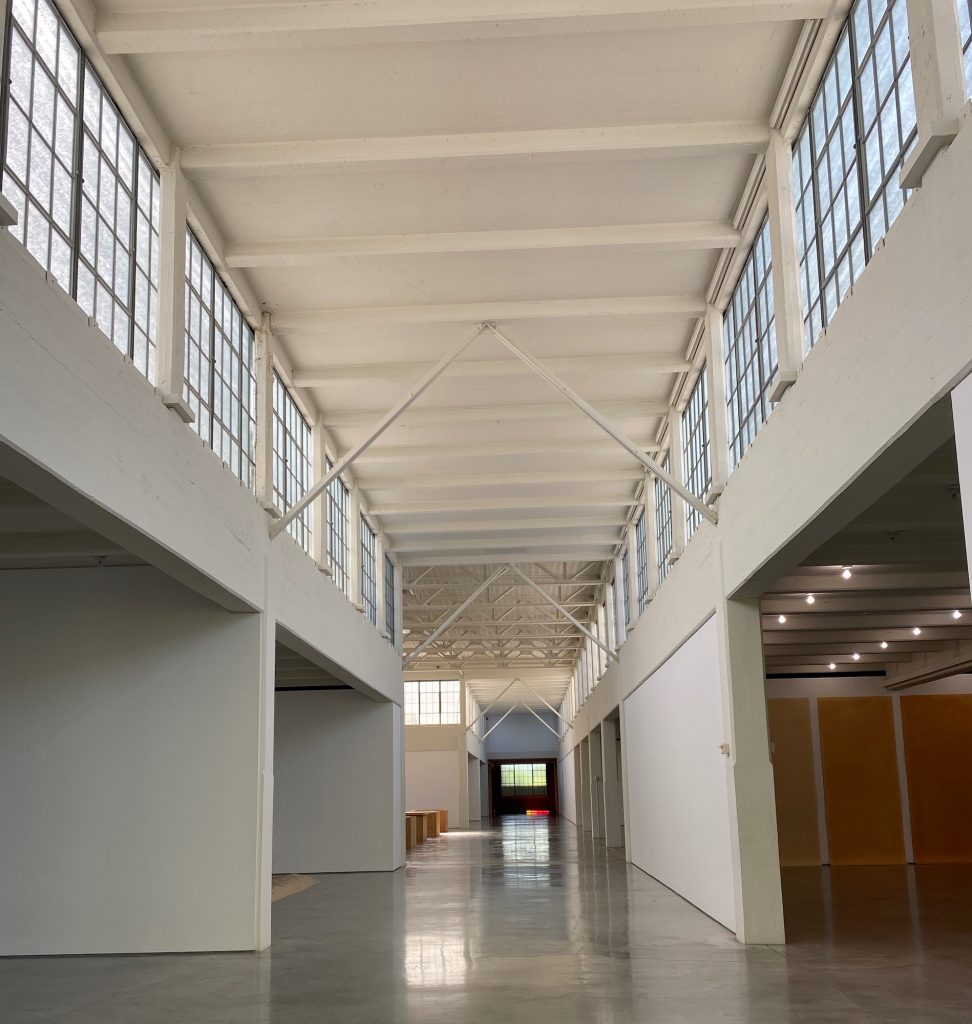
This was my first time to Dia Beacon. After months of looking at art online this in-person visit was shaped by a heightened sense of awareness. With a vague idea of the Dia Foundation’s origin story and familiarity with the artists that have been central to its programming, I was anticipating a shrine to the white male ego – a space that would feel out of step with the widespread turmoil and outrage towards the inequities that continue to plague institutions across all sectors, to which the art world has not been immune. However, as I made my way through the galleries, for the most part without disruption from others, I was overtaken by this space. The high ceilings, vast open spaces, exposed beams, brick walls, white surfaces, and abundance of natural light made for an unexpectedly moving experience.
The re-design of this former factory into Dia Beacon honored the founders’ original vision and relied on input from the artists whose work make up the foundation’s core collection. Acquisitions from the 1970s and 1980s, when the founders were most active as patrons and collectors, have been installed and/or realized on a semi-permanent to permanent basis. Recently and most significantly, Dia has taken steps to broaden its platform. These efforts, when combined with the founder’s original mission, is a reassuring shift that will hopefully continue to expand the depth and breadth of this foundation’s potential for future generations.
German gallery owner Heiner Friedrich, Fariha Friedrich (née de Menil) and Helen Winkler Fosdick founded Dia. Fariha, born Philippa de Menil, is the youngest daughter of John and Dominique de Menil, of the Schlumberger oil fortune. The Menil Collection in Houston, where this family’s world class art collection is housed in several buildings, is spread across an art campus including the Rothko Chapel. The term ‘dia’ is a Greek term that translates as ‘through’. Dia can also mean ‘the godlike one’ and has been used to describe the dynamic between the Dia founders/patrons, ‘dia-ties,’ and the artists, ‘dia-fied.’
Fariha and Heiner Friedrich were married (but have since divorced), converted to Sufi Islam (Philippa’s first name was changed to Fariha when she converted to Islam during the wedding ceremony to Heiner) and co-founded Dia with Helen Winkler in the mid to late 1970s. The founders had grand visions for the art that could be realized with the backing of Fariha’s wealth. They patronized projects that were not limited to the bounds of the conventional spaces or schedules of museums or galleries. This philosophy originated with Heiner Friedrich when he was a gallery owner in Germany and later in New York City. He sought permanence and, after joining forces with Fariha, he was able to fully realize a magnanimous vision of art collection/patronage. Rather than empty his gallery space and prepare for a new exhibition following Walter de Maria’s New York Earth Room installation in 1977, Friedrich left this gallery space filled with dirt to become a permanent exhibition and relocated to a new gallery space. This move was followed by another installation of De Maria, The Broken Kilometer (1979), which was placed on permanent view at 393 West Broadway in New York City. Dia also purchased a piece of land in Quemado, New Mexico for De Maria’s outdoor installation, The Lightening Field (1977). The Dia Foundation continues to maintain these sites.
In addition to De Maria, artists such as Donald Judd, Dan Flavin and Micheal Heizer were among a fortunate group of artists who had the freedom to design multi-million dollar projects, oftentimes involving the purchase of land and properties in remote locations. Today, the Dia Foundation’s custodial responsibilities encompass Robert Smithson’s Spiral Jetty (1970) in the Great Salt Lake of Utah, Nancy Holt’s Sun Tunnels (1973–76) in the Great Basin Desert in northwestern Utah, and other works conceived in the late 1970s.
By the time of Dia Beacon’s opening in 2003 the founders were no longer involved with the foundation in an official capacity. However, those in charge have welcomed their input along the way. Articles written in 1996 and 2003 offer more detailed accounts of the fascinating and complicated story of the Dia Foundation. They carefully trace the tumultuous journey that eventually led to the opening of Dia Beacon.
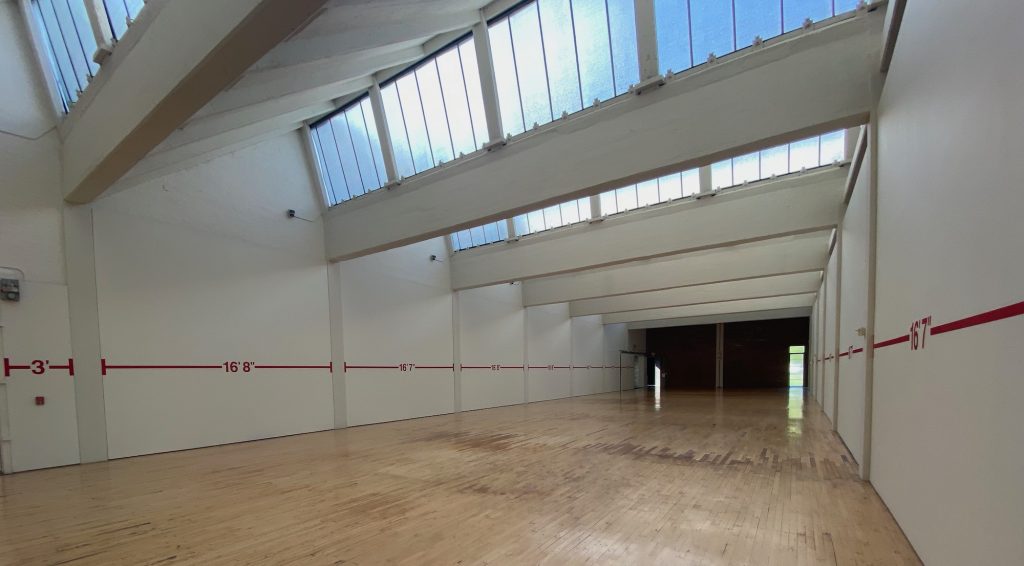
Visitors are free to move through the galleries without the guidance of an introductory text, a suggested route, or basic wall labels. Only the names of the artists appear discreetly and somewhat inconsistently on the gallery walls. Left to our own devices, the absence of educational material is at first a little frustrating. However the longing for supplemental information or viewing instruction fades as the senses take over.
Just past the main entrance and down the center of the building are two cavernous gallery spaces running parallel to each other. I wandered into Mel Bochner’s (born 1940) Measurement Room: No Vantage Point to find a Conceptual piece that had been tailored to the dimensions of this enormous space fifty years after the artist had first measured the space of Galerie Heiner Friedrich in Munich. The room is left empty but for the markings on the four walls. A horizontal line and numbers, in bold red, mark the dimensions of this space that was underwhelming upon first impression. In the next gallery, the complete set of Andy Warhol’s Shadows stretch across its four massive walls in a continuous row. The repeated, abstract forms of the 102 canvases are a welcome burst of color.
After touring these two galleries, the “Dia” vision is evident through the sheer magnitude and singular focus of each gallery space. This arrangement of large-scale installations, conveniently organized under one roof, gives one the sensation of moving through various and remote locations. Although I cannot speak from experience of visiting the sites overseen by the Dia Foundation, Beacon’s design and organization is transportive.
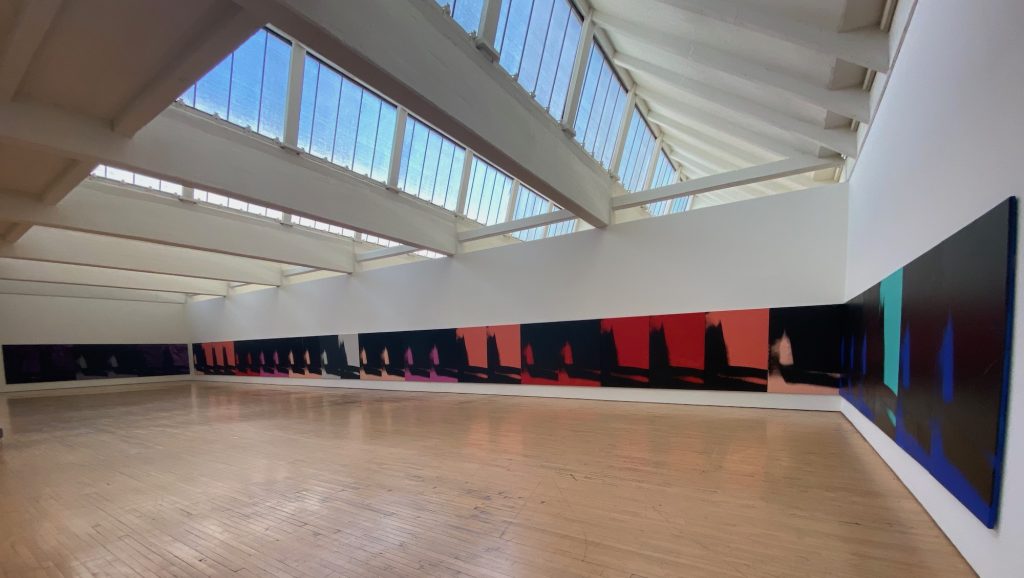
Moving towards the back of the building are two installations by the earthworks pioneer, Michael Heizer (born 1944). A boulder, of intimidating proportions, is tucked into a wall. Negative Megalith #5 is a natural altarpiece, a solid mass radiating a calm, soothing sensation in opposition to the downward pull of the four gaping openings of North, East, South, West. Heizer partially executed these “negative sculptures” in 1967. He realized them as a complete set of four geometric shapes specifically for this interior space. The transparent barrier limiting access to the floor’s edge of these deep spaces resplendent with natural light pouring through the wall of windows is necessary. The emptiness of these mammoth orifices is simultaneously terrifying and captivating but kept in check by the barrier protecting the body of the viewer.
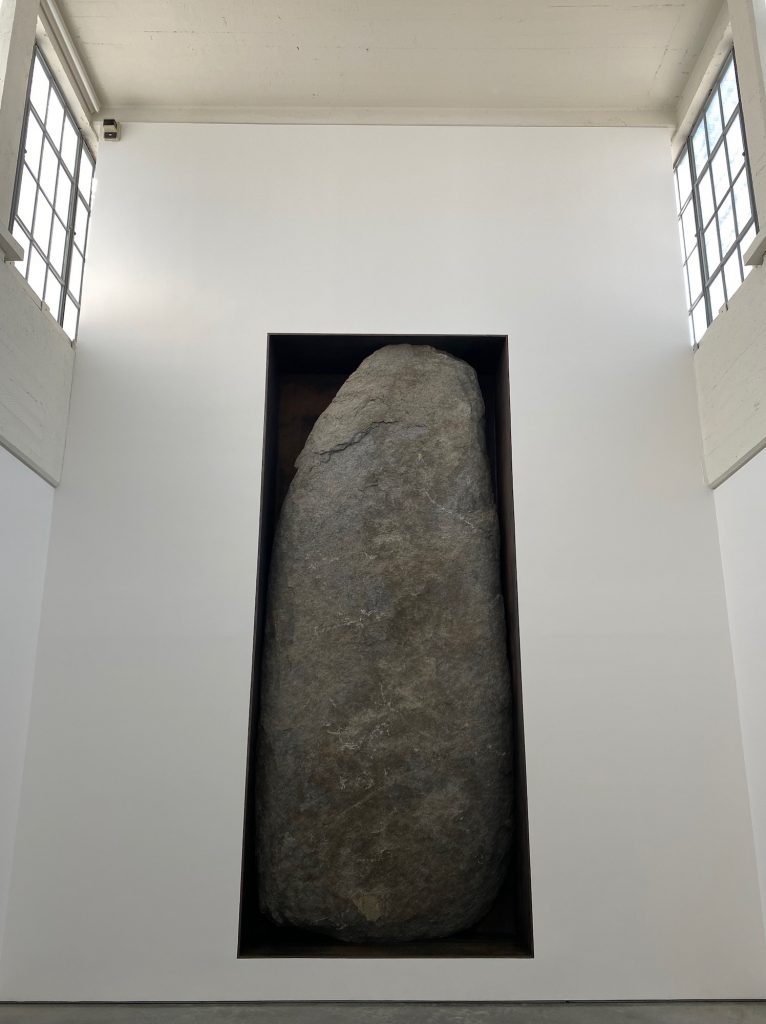
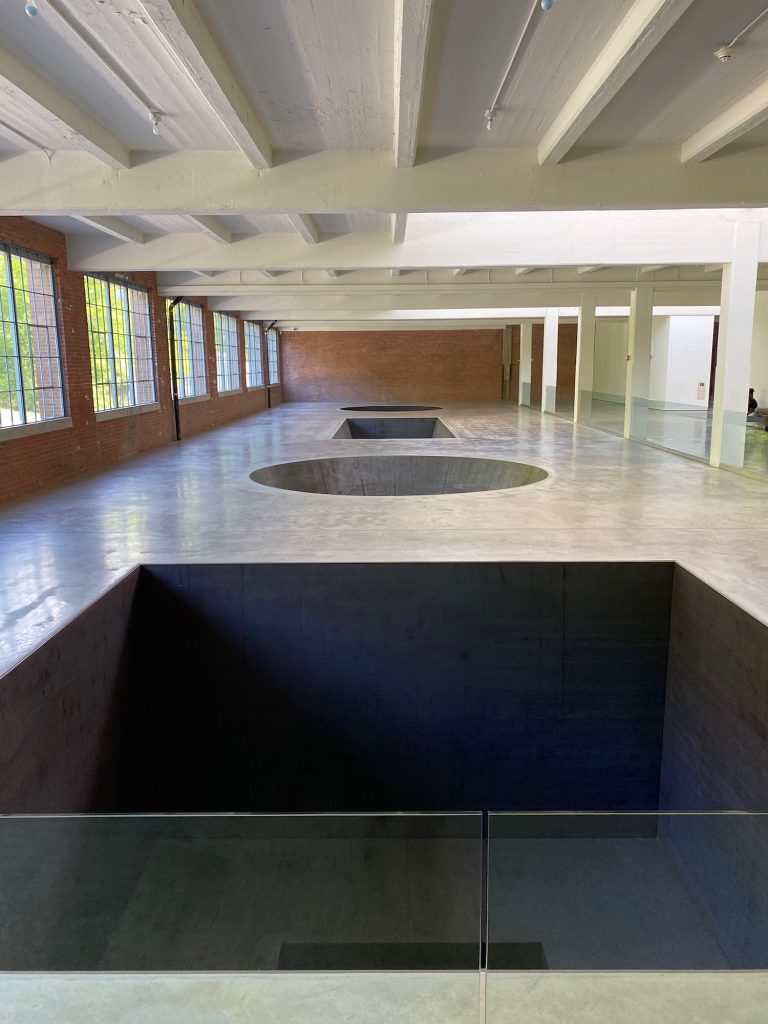
The subtle expansion of scope, reaching beyond American and German experimentation from the period of the 1960s onward, has prompted Dia to acquire works from the Korean artist Lee Ufan (born 1936). This artist moved to Japan from Korea in the 1950s and emerged as a leader of the Japanese art movement Mona-Ha (1968-1972). Translated as “The School of Things,” this movement was led by Lee’s theoretical writing, heavily influenced by the political unrest of the times as well as eastern and western philosophy. This art movement centered around site-specific installations and the use of natural and industrial found materials such as rocks, sand, wood, cotton, glass, and metal. Mona-Ha installations were meant to be destroyed to resist collection, monetization, ownership, and authorship. Lee’s reincarnation of Relatum, (formerly Iron Field) in 2019, exactly fifty years after it was first executed, demonstrates the delicate balance between sand and steel. Thin, man-made steel “twigs” stand at attention in a dense layer of sand covering the floor. This arrangement of steel sprigs in the sand defies logic given the properties normally associated with the weight and mass of each material.
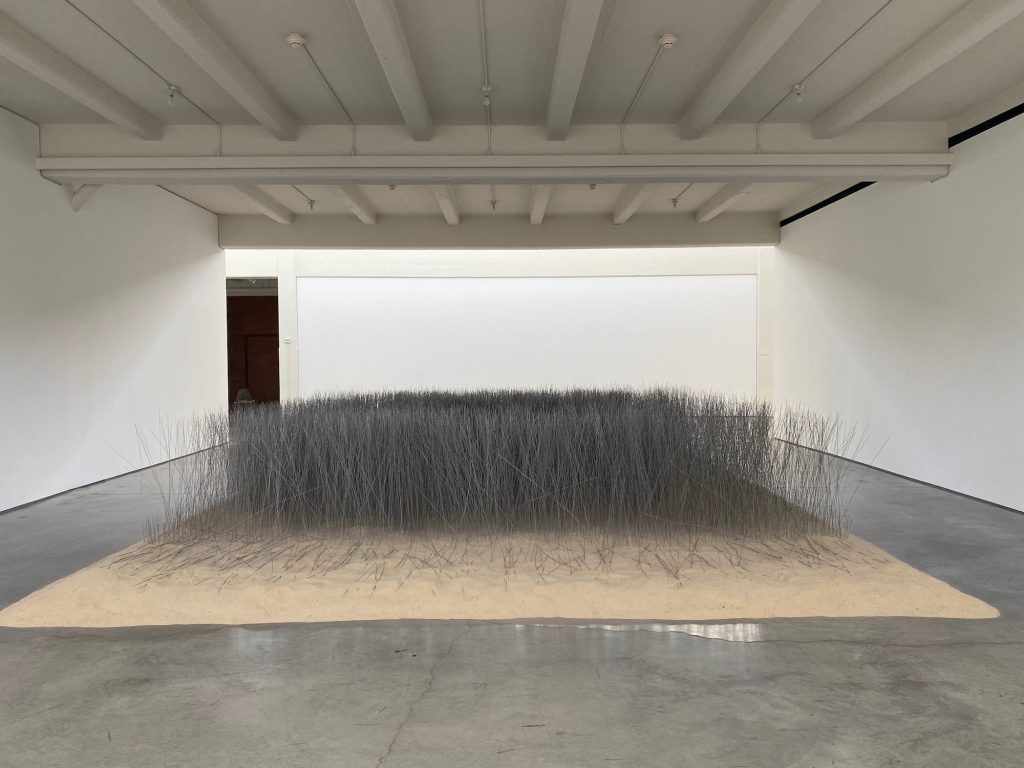
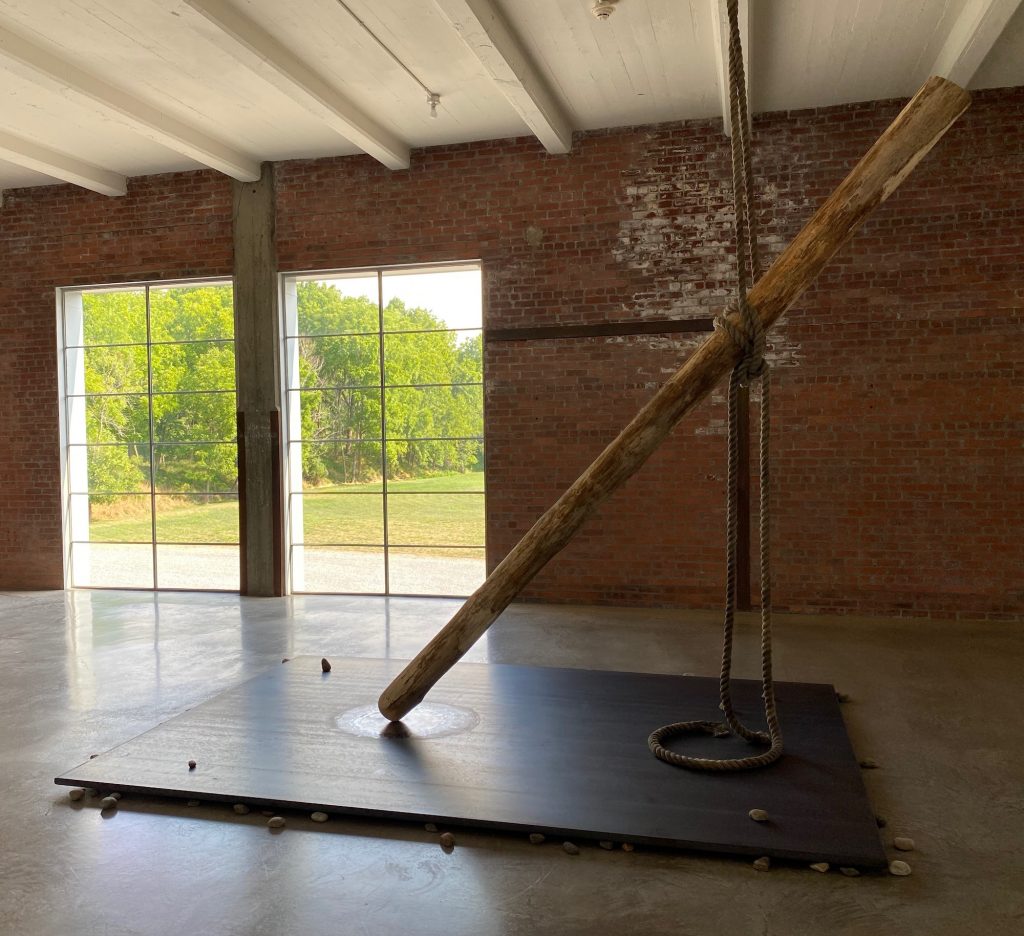
In another room is Lee’s Relatum (1974/2019), a log dangling precariously on a diagonal over a steel platform and secured by a rope hanging from the ceiling. The steel platform is slightly raised from the ground because it has been placed on top of small rocks scattered across the floor. The point of contact between steel and wood is not secured but is marked by a worn circle on the platform’s surface. This is suggestive of meditative practices or the repetitive and restricted movements of the suspended log. Lee’s work is a balancing act around polarities that in this environment allows the viewer ample opportunity for quiet and prolonged contemplation.
Richard Serra’s (born 1938) Torqued Ellipses are drench in sunlight and swirl in a space. These four interactive sculptures sit inside the rear mezzanine of what was once the train depot of the former factory. These curved forms of weathered steel express Serra’s decades-long experimentation with industrial materials. The heavy walls close in around the body as one moves through the tight corridors of the tilted spirals or steps directly into the center of an ellipse. The daring tilt of the steel walls counters thinner serenity of each core. Quietly moving in and out of these monumental steel forms is intimidating yet hypnotic. It is a thrill to find the center but also a relief to have escaped.
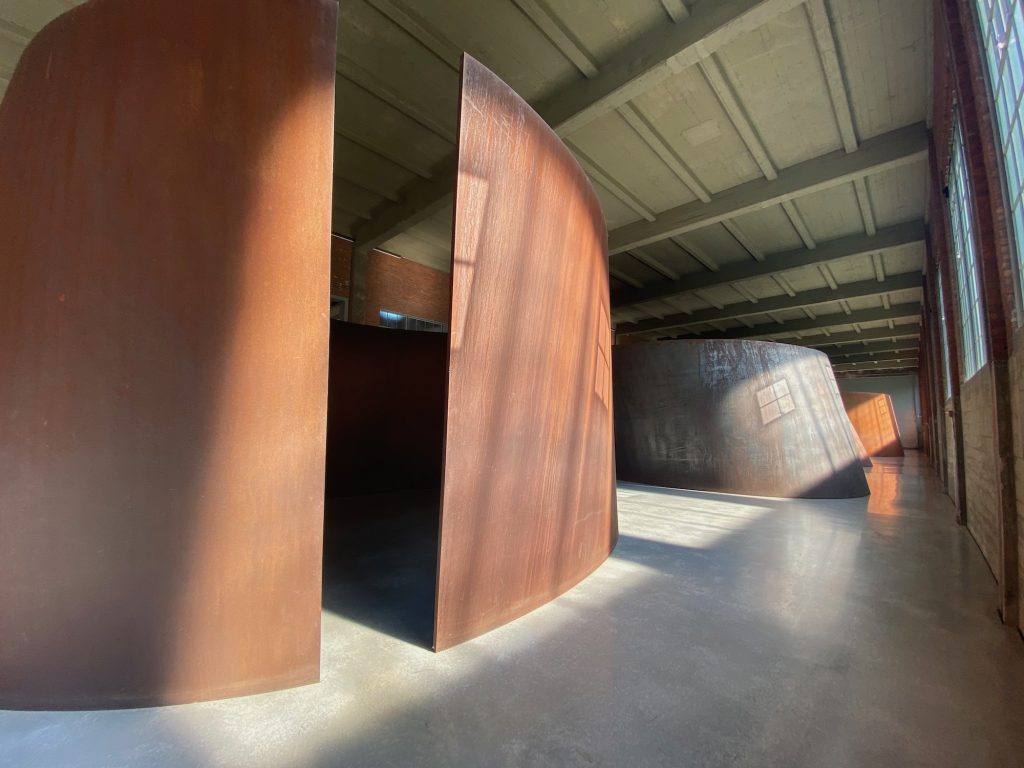
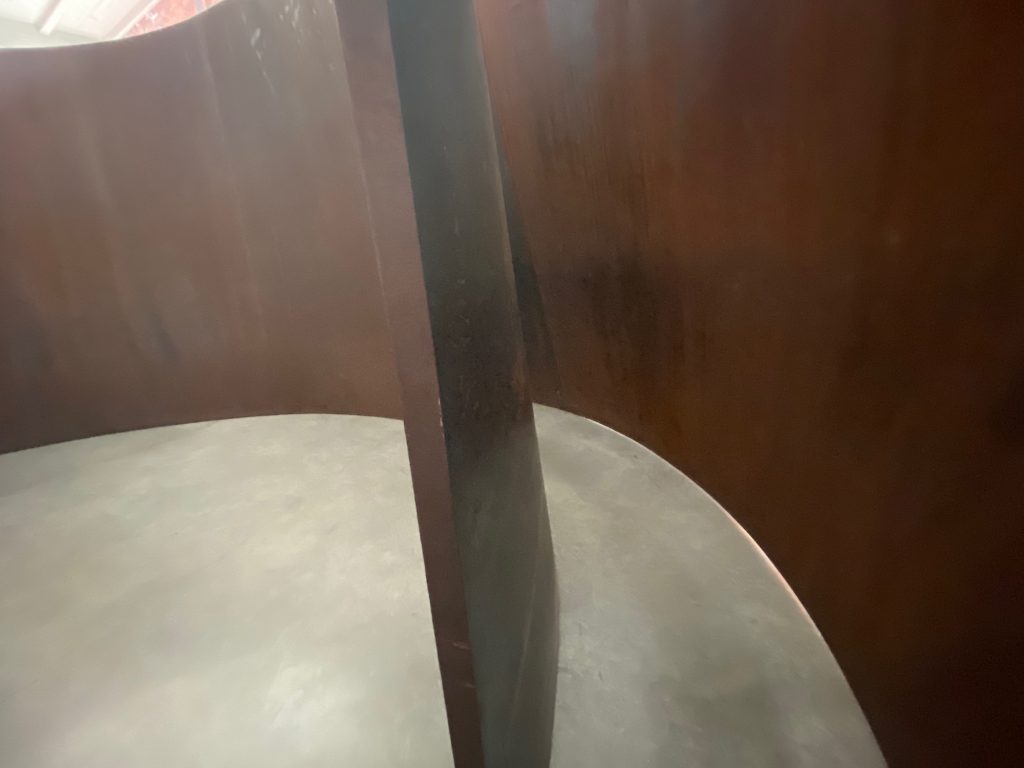
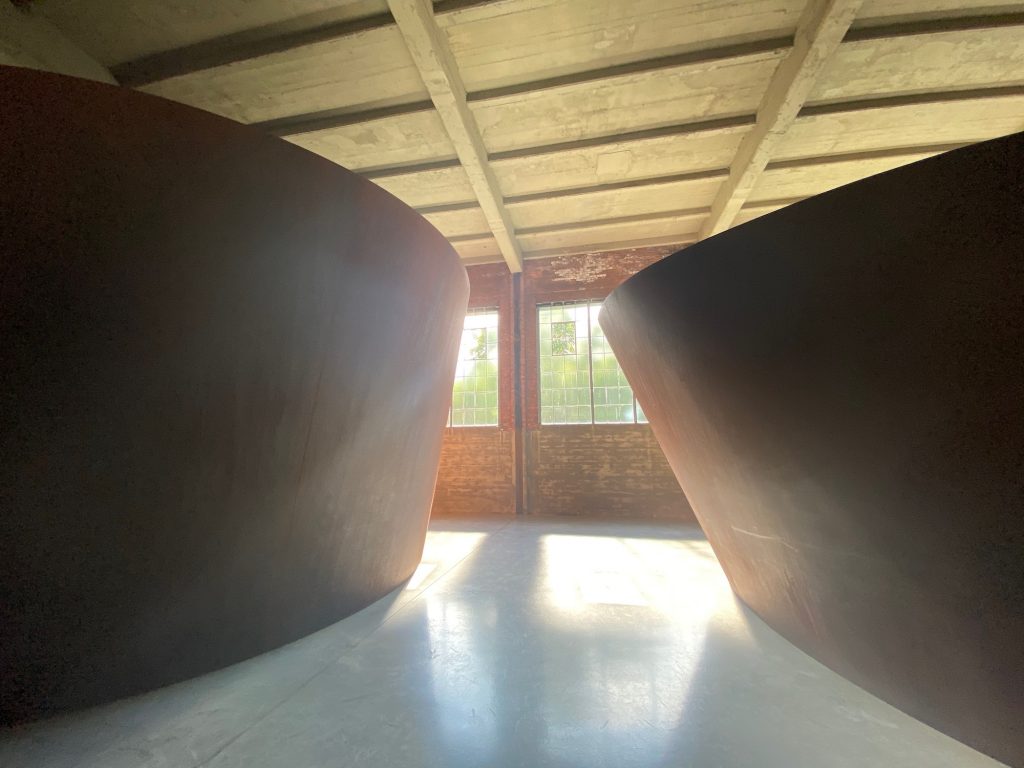
Downstairs in the dark basement, a steady beat and strobe light transported me to another realm, to the most unanticipated of places – a dance club. I was immersed in Carl Craig’s (born 1969) Party/After-Party. Craig stands out among the group of artists at Dia because he is of a younger generation and from the world of music. It was mesmerizing to wander through this underground sound installation after months of living in an eerily quiet version of New York City. Craig’s installation was intermittently illuminated by flickering strobe lights and a central spotlight to match the intense dance beats pumping out of immense speakers.
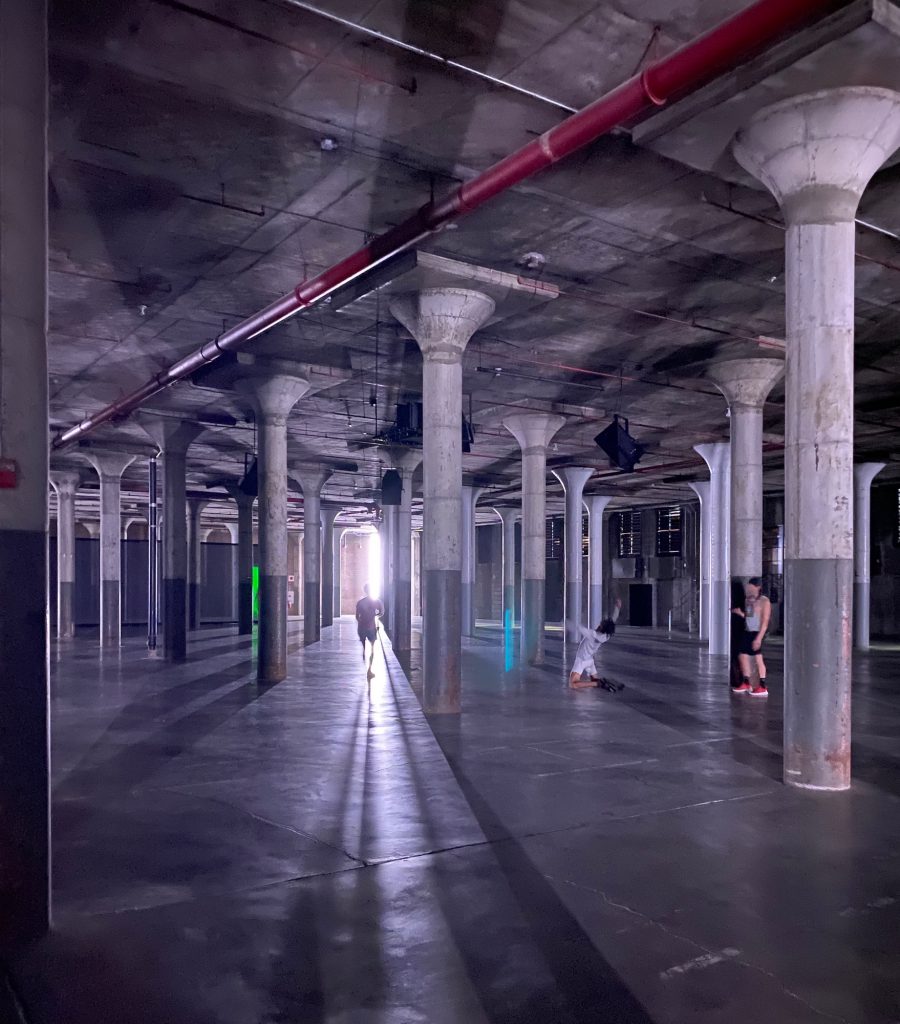
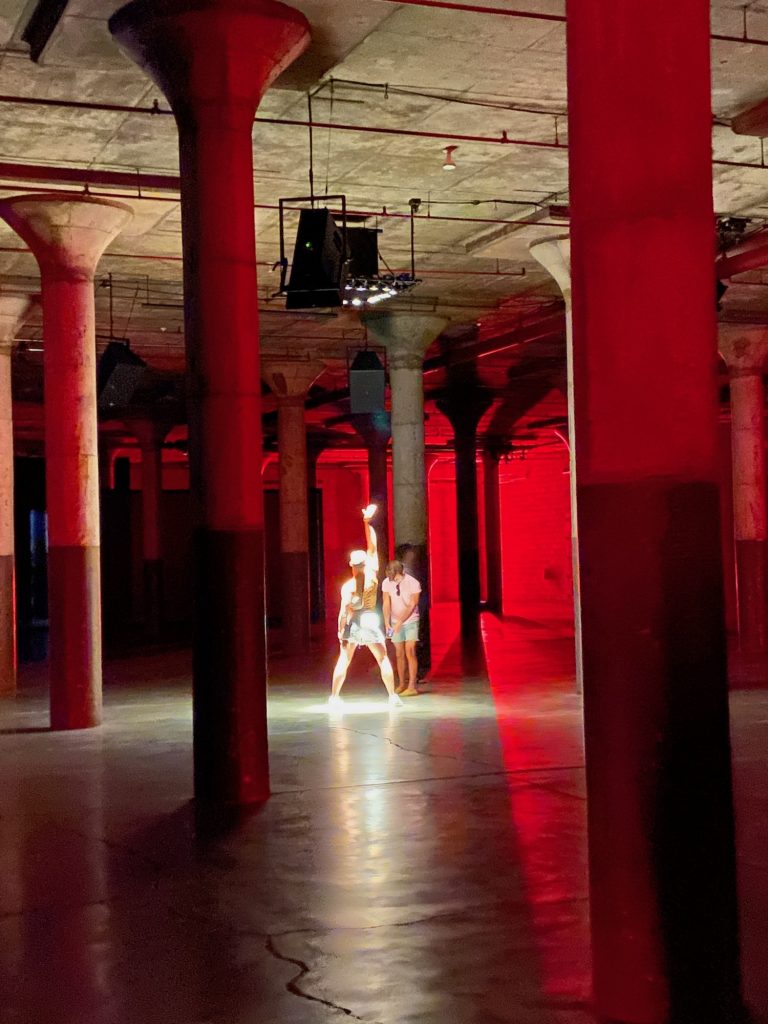
Detroit-based and world-renown DJ and producer Carl Craig conceived this audio piece to relay the periods of loneliness, solitude, and isolation felt by someone in his profession who travels incessantly around the globe to host dance parties in large clubs and arenas. However, during my visit, this work felt like the-long-overdue-party. I witnessed a small group of young men taking full advantage of this dance space. The rhythmic beats and the pure sense of joy generated by these graceful dancers entranced me. Their exuberance was a reminder that many have not had a place to burn off steam, socialize, have the night of their life, or just go out in the evenings and let loose. These dancers filled the space with positivity, excitement, anticipation, and the rush of adrenaline reminiscent of youthful nights out. So many young and single people in urban environments rely on these public spaces to feel connected with the world. After a prolonged period of knowing that many were feeling isolated or disconnected, Party/After-Party was a flashback to the old normal – a welcome break from the new abnormal.
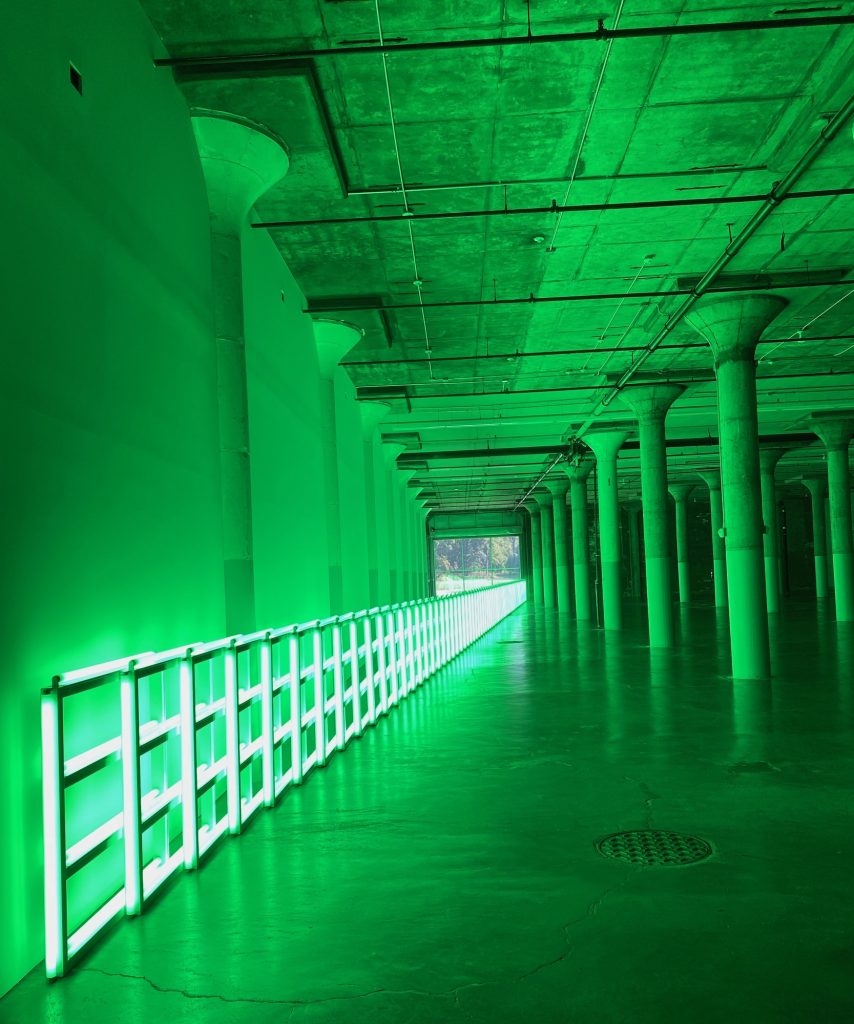
Craig’s Party/After-Party was complemented by Dan Flavin’s (1933-1996) fluorescent light installation, untitled (to you, Heiner, with admiration and affection). Sixty-nine fluorescent squares arranged as a long diagonal line illuminated this dark room in the basement. This installation is divine, an aspect further reinforced by the title’s reference to the special friendship between the artist and patron. The relationship between Flavin and the founders brought to fruition some interesting collaborations. In the late 1970s the artist contributed light installations to a building that Dia had purchased and converted into a mosque, Masjid Al-Farah. In addition to serving as a spiritual center, the former fire station at 155 Mercer Street temporarily housed the offices of the foundation. The spirituality that had guided the founders early on is evident at Dia Beacon today. Flavin’s trademark fluorescent lights glow in the darkness, transforming this basement space into a meditative space. Given the current state of anxiety, anger, and fear, it did not feel unreasonable to look at this piece and wonder if this was the light at the end of the tunnel. Moved by the underground audio and light installations of the basement, I returned to the main floor feeling hopeful.
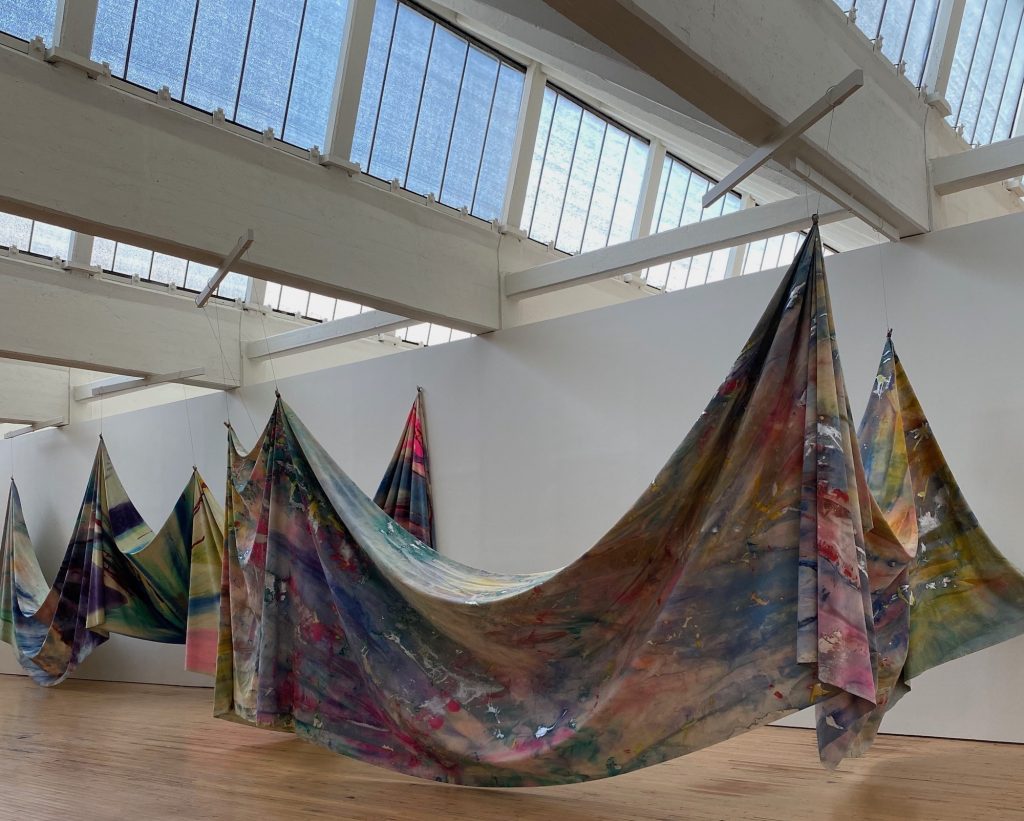
Back on ground level where natural light reigns, is a long-term installation by Sam Gilliam’s (born 1933) of color-soaked canvases gracefully draped from the ceiling. From Washington D.C. and contemporaneous to the Washington Colorfield School, Gilliam distinguished himself from Kenneth Nolan and Morris Louis with canvases released from the stretcher and presented as three-dimensional installations. The gentle cascade of the fabric folds occupying the space between ceiling and the floor hung in contrast to the firmly grounded and crushed automobile sculptures of John Chamberlain (1927-2011) installed in one of the four nave-like spaces running from the front of the building. Graced by a wall of windows, this playful arrangement of colorful and crushed auto parts is bathed in sunlight.
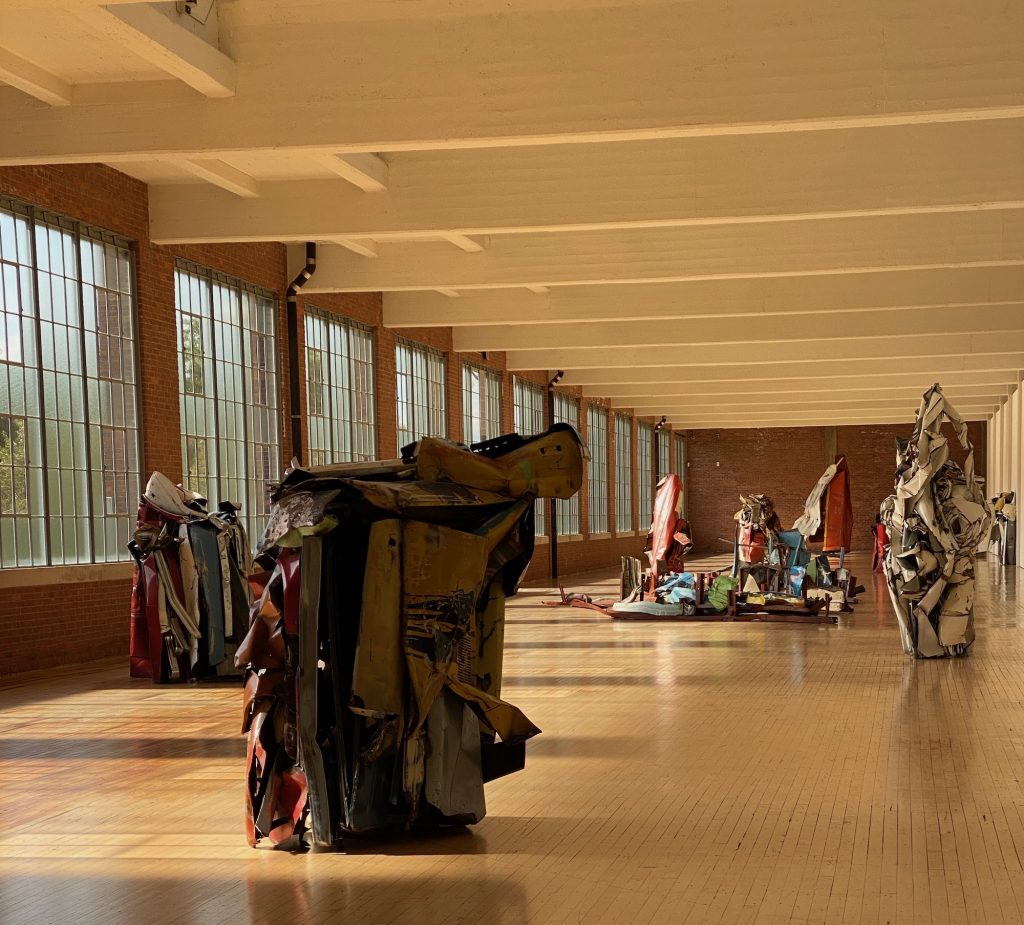
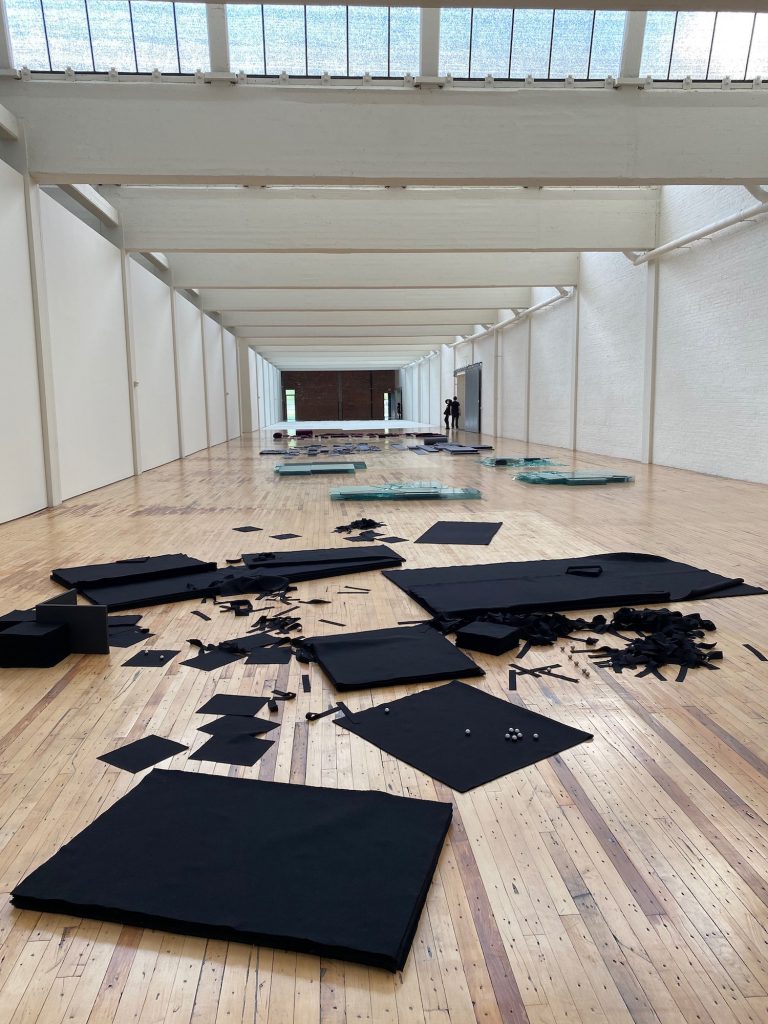
Weaving in between and around the Chamberlain gallery, I found myself back at the entrance and facing the parallel gallery of Barry Le Va (born 1941). These carefully orchestrated installations of of broken glass, pieces of felt, and scraped chalk covered this large floor space. One’s attention was drawn downward to further investigate these arrangements of destruction dictating the movements of the viewer, who is prohibited from walking across one half the floor space covered in waves of chalk scrapings.
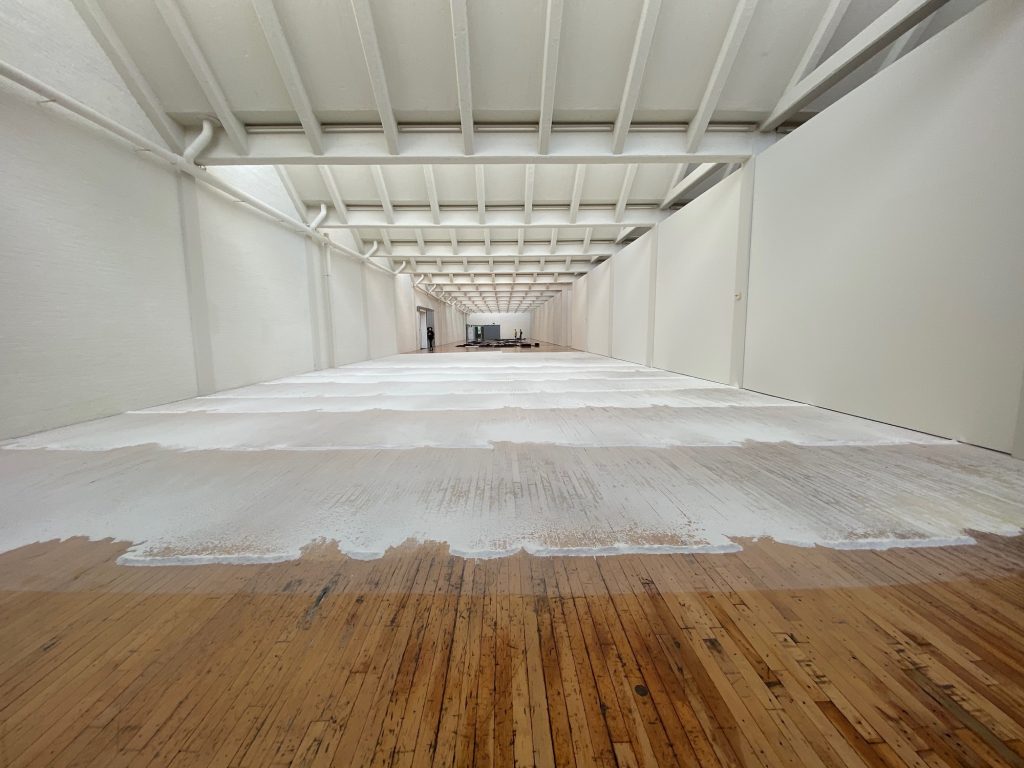
This day at Dia concluded in the attic where Louise Bourgeois (1911-2010) held court. These rooms are devoted to a selection of long-term loans from the Easton Foundation. Tucked away in the room farthest from the staircase leading up to the attic and patiently waiting to greet visitors is a Bourgeois spider. Like a sage, and not menacing despite its magnified proportions, this arachnid form is a comforting sight. The concept of the spider was a source of warmth for the artist. She associated this creature’s ability to spin webs with her mother who worked with tapestries. The artist devoted her final years to this subject, eventually churning out an army of spiders that are now stationed around the globe.
Dia Beacon is a breath of fresh air where one can escape and take a break from these confusing and infuriating times. The pilgrimage to Beacon, New York rewards one with the opportunity to wander through a dynamic selection of Dia sites, conveniently located under one roof and in aesthetically pleasing surroundings.
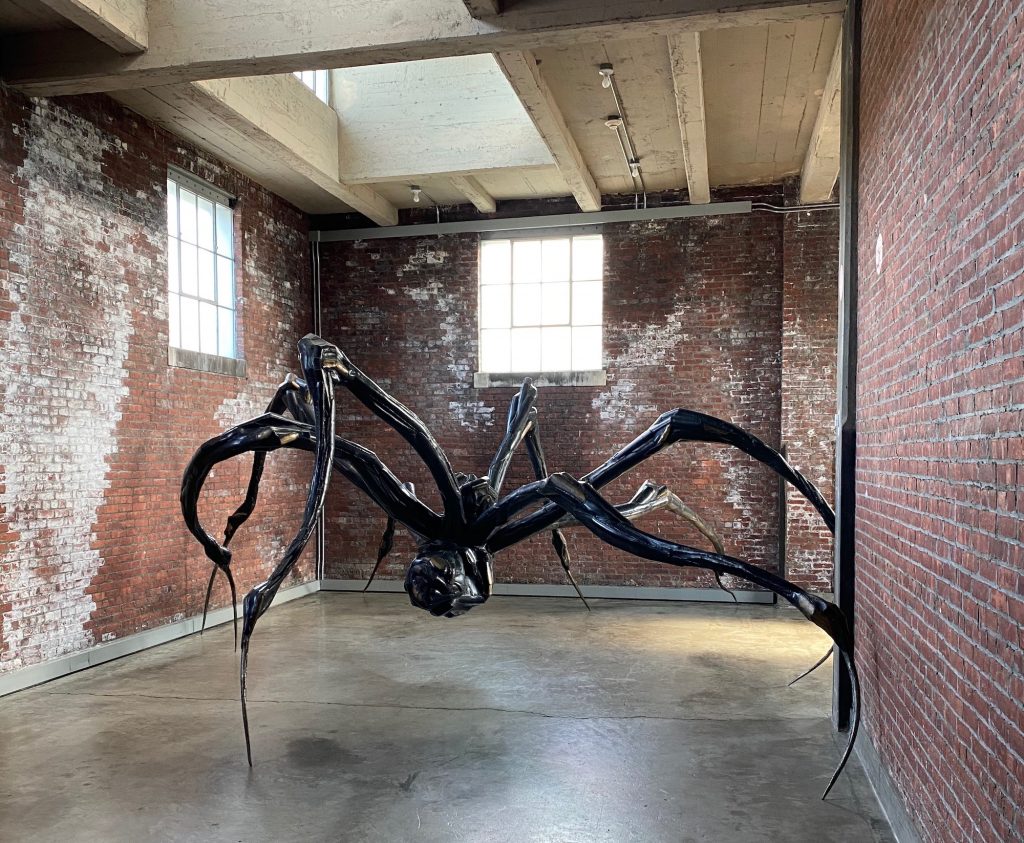
DailyArt Magazine needs your support. Every contribution, however big or small, is very valuable for our future. Thanks to it, we will be able to sustain and grow the Magazine. Thank you for your help!